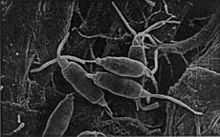Pestalotiopsis microspora
Pestalotiopsis microspora is a species of endophytic fungus capable of breaking down and digesting polyurethane.[1] Originally identified in fallen foliage of common ivy (Hederae helicis) in Buenos Aires,[2] it also causes leaf spot in Hidcote (Hypericum patulum) shrubs in Japan.[3]
Its polyurethane degradation activity was discovered in the Yasuni National Forest within the Ecuadorian Amazonian rainforest by a group of student researchers led by molecular biochemistry professor Scott Strobel as part of Yale's annual Rainforest Expedition and Laboratory. It's the first fungus species to be able to survive exclusively on polyurethane and, more importantly, able to do so in anaerobic conditions. This makes the fungus a potential candidate for bioremediation projects involving large quantities of plastic.
References
- ↑ Jonathan R. Russell, Jeffrey Huang, Pria Anand, Kaury Kucera, Amanda G. Sandoval, Kathleen W. Dantzler, DaShawn Hickman, Justin Jee, Farrah M. Kimovec, David Koppstein, Daniel H. Marks, Paul A. Mittermiller, Salvador Joel Núñez, Marina Santiago, Maria A. Townes, Michael Vishnevetsky, Neely E. Williams, Mario Percy Núñez Vargas, Lori-Ann Boulanger, Carol Bascom-Slack, and Scott A. Strobel (15 July 2011). "Biodegradation of Polyester Polyurethane by Endophytic Fungi". Applied and Environmental Microbiology (Washington, DC: American Society for Microbiology) 77 (17): 6076–6084. doi:10.1128/AEM.00521-11. ISSN 1098-5336. PMC 3165411. PMID 21764951. Retrieved 1 February 2012.
- ↑ Saccardo, Pier Andrea. Sylloge fungorum omnium hucusque cognitorum (in Latin) 3. p. 789. OL 7025165M.
- ↑ Zhang, M.; Wu, H.Y.; Tsukiboshi, T.; Okabe, I. (August 2010). "First Report of Pestalotiopsis microspora Causing Leaf Spot of Hidcote (Hypericum patulum) in Japan". Plant Disease 94 (8): 1064. doi:10.1094/PDIS-94-8-1064B.
External links
